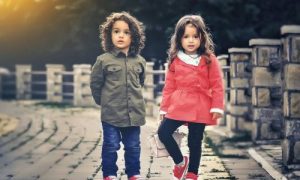
In today’s world, sustainability is at the forefront of many industries, and fashion is no exception. With increasing awareness about the environmental impact of fast fashion, many parents are turning to eco-friendly alternatives for their children’s clothing. Fashion choices for children can significantly contribute to shaping a more sustainable future.
This article explores the rise of eco-friendly kids’ fashion, highlighting the benefits of sustainable styles, the top materials used, ethical practices in production, and the leading brands making a difference. It also provides practical tips for parents looking to make more conscious choices when dressing their little ones.
The Growing Importance of Eco-Friendly Kids’ Fashion
As the fashion industry continues to be one of the most significant contributors to environmental damage, there is a rising awareness of the need for sustainable fashion. For kids, who tend to grow out of clothes quickly, the demand for eco-friendly fashion has never been more critical. From reducing textile waste to minimizing carbon footprints, every aspect of the clothing production process can have an environmental impact. As more parents recognize the value of investing in sustainable clothing for their children, eco-friendly fashion for kids has become a growing trend, blending style, comfort, and ethical practices.
Why Sustainable Kids’ Fashion Matters
1. Reducing Textile Waste
The global textile industry generates millions of tons of waste each year. Children’s clothing is particularly prone to being outgrown quickly, leading to a high turnover of garments. By choosing eco-friendly options, parents can ensure their purchases last longer, reducing the need for constant replacements.
2. Sustainable Production Practices
Traditional fashion production involves chemical dyes, pesticides, and synthetic materials, all of which harm the environment. Eco-friendly kids’ fashion emphasizes natural materials, organic farming practices, and ethical manufacturing processes, promoting a more sustainable approach to clothing production.
3. Healthier Clothing for Kids
Sustainable clothing is typically crafted from organic materials that skip the harsh chemicals, making them gentler on both your skin and the planet. This is particularly important for children’s sensitive skin, as exposure to toxic substances in clothing can lead to allergic reactions, skin irritation, and other health issues.
4. Support for Ethical Brands
Supporting eco-friendly kids’ fashion brands also helps support fair labour practices. Many sustainable brands focus on providing fair wages and safe working conditions for their employees, promoting both environmental and social responsibility.
Top Sustainable Materials in Kids’ Fashion
When it comes to eco-friendly kids’ fashion, the materials used play a crucial role. Sustainable fabrics help reduce the environmental impact of clothing production and provide a healthier alternative for children. Here are some of the most popular materials in sustainable kids’ fashion:
1. Organic Cotton
Organic cotton is one of the most widely used materials in eco-friendly kids’ fashion. Unlike conventional cotton, which is often grown with chemical pesticides and fertilizers, organic cotton is produced without harmful chemicals. It’s also grown using methods that help preserve soil health and reduce water consumption. Organic cotton is soft, breathable, and gentle on a child’s sensitive skin, making it an excellent choice for clothing.
2. Hemp
Hemp is a highly sustainable fabric that’s grown with minimal environmental impact. It requires little water and no pesticides to thrive, making it an eco-friendly alternative to cotton. Hemp is durable, breathable, and naturally resistant to mould and UV rays, making it perfect for kids’ clothing that needs to stand up to active play.
3. Tencel (Lyocell)
Tencel, also known as Lyocell, is an eco-friendly fabric made from wood pulp, most commonly harvested from fast-growing eucalyptus trees. Tencel production uses a closed-loop system, meaning the chemicals used in the manufacturing process are recycled and reused. The result is a fabric that’s soft, breathable, and biodegradable, making it an excellent choice for children’s clothing.
4. Recycled Polyester
Recycled polyester is created from plastic bottles and other waste products, providing an eco-friendly alternative to virgin polyester. Reusing plastic waste helps conserve natural resources and reduce energy use. Tough and moisture-wicking, this material is ideal for keeping active kids comfortable and dry.
5. Wool
Wool is a natural fibre that is biodegradable and renewable. When sourced ethically, wool can be an eco-friendly material for kids’ clothing. Wool is known for its warmth, breathability, and moisture-wicking properties, making it ideal for outerwear and cosy sweaters. It’s also naturally resistant to odour and stains, making it practical for kids’ clothing.
6. Bamboo
Bamboo is a rapidly growing plant that needs little water and no pesticides, making it an incredibly sustainable resource. The fabric is gentle, breathable, and kind to sensitive skin, making it an excellent option for kids’ clothing.
The Role of Ethical Manufacturing in Kids’ Fashion
Sustainability in fashion goes beyond materials—ethical manufacturing plays an equally important role. Brands that focus on ethical production ensure fair wages, safe working conditions, and respect for their workers, contributing to the social responsibility aspect of eco-friendly fashion.
Fair Trade Certifications
Many eco-friendly kids’ clothing brands are certified by Fair Trade organizations, which guarantee that workers receive fair wages and work in safe, ethical conditions. Fair Trade certification ensures that the supply chain is transparent and that companies adhere to strict environmental and social standards.
Local Production and Small-Scale Manufacturing
Many sustainable brands focus on local production to reduce the carbon footprint of transporting goods across long distances. By supporting small-scale manufacturing, these brands also help promote fair labour practices and invest in local economies.
Eco-Friendly Kids’ Fashion Brands Leading the Way
Several brands have emerged as leaders in the eco-friendly kids’ fashion space. These companies are committed to sustainable materials, ethical manufacturing practices, and creating stylish clothes that parents and kids love.
1. Patagonia Kids
Patagonia is well-known for its commitment to sustainability, and its kids’ collection is no different. The brand incorporates recycled materials, organic cotton, and Fair Trade-certified production methods. With a focus on durability, Patagonia creates clothing built to last, helping to minimize waste.
2. Frugi
Frugi is a UK-based brand that offers a wide range of organic cotton clothing for children. Their garments are made from certified organic cotton, and the company is committed to reducing its carbon footprint. Frugi also supports Fair Trade practices and has a strong focus on ethical sourcing and production.
3. Mini Rodini
Their pieces are made with organic cotton, recycled materials, and other sustainable fabrics. Dedicated to ethical production, Mini Rodini guarantees fair wages and safe working environments for all its workers.
4. Bobo Choses
Bob Choses is a Spanish brand known for its playful and artistic designs. The brand uses organic cotton and other sustainable materials in its kids’ clothing. Bobo Choses is dedicated to making a positive impact on the planet and offers clothing that is both eco-friendly and fashionable.
5. Hanna Andersson
Hanna Andersson is a family-owned brand that focuses on creating high-quality, long-lasting kids’ clothing made from organic cotton. The brand’s clothes are designed for durability, ensuring that they can be handed down to siblings or even friends. Hanna Andersson also prioritizes sustainability in its production process and packaging.
How to Make Eco-Friendly Choices When Shopping for Kids’ Fashion

As parents become more conscious of their environmental impact, there are several ways they can make eco-friendly choices when shopping for their children’s clothing. Here are some practical tips for parents looking to reduce their environmental footprint:
1. Buy Less, Choose Wisely
Rather than buying fast fashion that is trendy but not built to last, focus on investing in high-quality, durable clothing that will withstand the wear and tear of daily life. Consider purchasing fewer but better-made pieces that can be handed down or reused.
2. Embrace Secondhand Shopping
Shopping secondhand is an excellent way to score high-quality, eco-friendly kids’ clothing without breaking the bank. Thrift stores, consignment shops, and online marketplaces like ThredUp and Poshmark offer gently used clothing that’s still in excellent condition. Buying secondhand does help reduce textile waste and supports a circular fashion economy.
3. Focus on Versace, Timeless Pieces
Instead of buying trendy pieces that your child will quickly outgrow or lose interest in, invest in versatile, timeless clothing that can be worn for multiple occasions. Simple dresses, t-shirts, and pants in neutral colours or classic patterns can be mixed and matched to create a variety of outfits.
4. Take Care of Your Clothes
Taking care of and repairing clothes can extend their lifespan, cutting down on the need for replacements. Teach your kids how to take care of their clothes by washing them correctly, mending small holes, and preventing unnecessary damage.
A Sustainable Future for Kids’ Fashion
As awareness about sustainability continues to grow, the future of kids’ fashion looks increasingly eco-conscious. More brands are expected to adopt sustainable practices, and eco-friendly materials will become even more accessible and affordable. As parents continue to prioritize the environment in their purchasing decisions, the fashion industry will likely shift towards more sustainable and ethical practices across the board.
In conclusion, eco-friendly kids’ fashion offers parents an excellent opportunity to make a positive impact on the planet while ensuring their children are dressed in comfortable, stylish, and safe clothing. Supporting ethical brands, opting for sustainable materials, and being mindful of consumption habits all contribute to creating a brighter, more sustainable future for the next generation.



